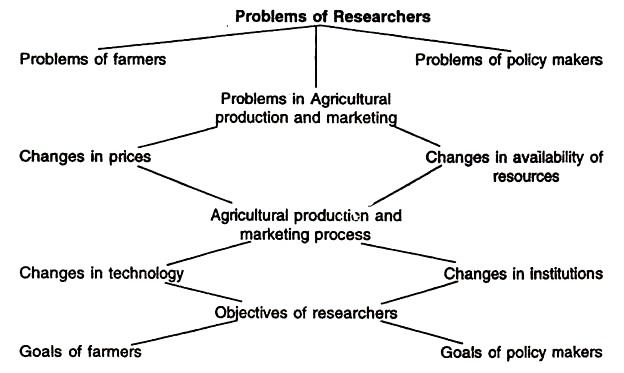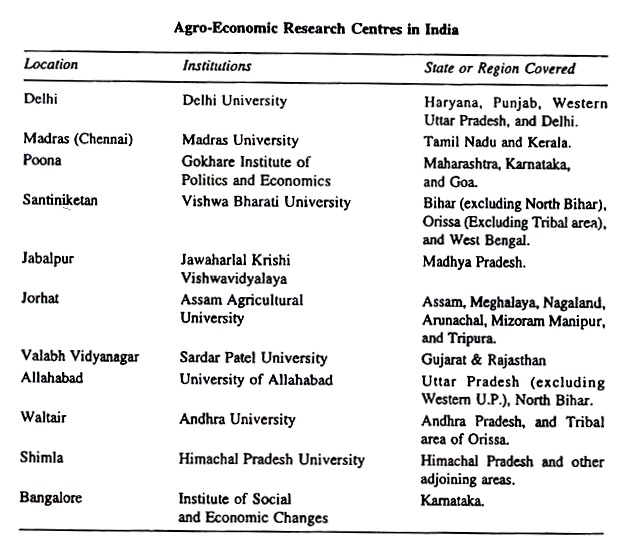After reading this article you will learn about:- 1. Sources of Farm Management 2. Sampling Procedure of Farm Management 3. Methods 4. Suggestions 5. Alternative Means 6. Areas.
Sources of Farm Management:
The management data is obtained from four major sources:
(a) Farm accounts,
(b) Farm surveys,
(c) Individual farmers,
(d) Theoretical farm models.
Sampling Procedure of Farm Management:
The sampling procedures used in farm management researches are:
(a) Block sampling,
(b) Random sampling,
(c) Stratified sampling,
(d) Stratified random sampling,
(e) Purposive sampling.
The general field of farm management data includes information’s that deals with farmers as a group or class and that dealing with individual farmers on their respective farms (this may be for case study or survey). The more general facts concerning farmers as a group is obtained from census reports, agricultural year book, crop and livestock statistics, blocks etc. The details of specific farms are collected from the producers.
Methods of Farm Management:
In the determination of relationships and the establishment of management principles include:
(a) Method of direct comparison,
(b) Method of budget analysis,
(c) The case study method,
(d) The multiple co-relation analysis,
(e) The economic theory or theoretical approach.
a. Method of Direct Comparison:
One group of farm is compared with the other group thus determining the effect of one or more management factors on costs and returns. The example is found in financial or credit management by the farmers having obtained an assured loan from the institutional finances resources.
The method of direct comparison is based on the assumption that economic events follow a more or less definite pattern and trend to repeat themselves. It assumes that the farms in a well-established farming region have been subjected to all the economic, physical forces that exist in the area. This method is a very useful approach for basic studies of farm management problems in any area.
b. Method of Budget Analysis:
The budget is usually considered to be a plan for future spending. But in case of farm budget strong and weak points are revealed for affecting alternative management practices for the optimum use of resources. This will bring forth the economic use of farm resources for highest income. But it is important to see into the correctness of input-output data. This is a valuable tool to study farm management problems.
This method is of great use in the farm advisory agencies or banking institution giving loans to farmers to uplift the economic conditions of the farmers. It provides reasonable indication to future possibilities of better running of the farm.
c. Case Study Analysis:
It is an intensive study of a small number of individual farms. The usual approach is to study various elements which make up, the farm unit. It gives the entire picture of the farms as they exist and the principles thus worked out could be applied to other farms.
The study is an exercise in quantitative analysis and appraisals. If this method is handled with less skill inaccurate conclusion may come up but on the other hand it may bring about a very conclusive principle. The results from this study can substantiate results of other methods used.
d. Multiple Co-relation Analysis:
This method uses statistical formulae by which the net effect of each of number of independent variables on cost and returns is established and the multiple effect of the more important independent variables on dependent items, farm returns, is computed. The results are expressed in term of coefficients of determination of each individual item and a multiple co-relation coefficient for the combined effect of all factors on farm returns.
This method has several drawbacks such as change in any one factor results in change in most of the other factors, and these joint relationship cannot be considered in their proper prospective in the usual multiple or curve-linear correlation analysis. This method also verifies the results obtained from other methods used in analysis.
e. Theoretical Approaches:
Theory is a positive approach of cause and effect relationship that, under specified conditions, or assumptions give rise to certain events or facts. The function of theory is, however, to explain a result after it has occurred and involves the establishment of assumptions rather than analysis of facts.
Economic theory is best defined as a body of principles, developed logically from basic assumptions, which are useful in analysing economic matters, “The theoretical approach to a study of farm management problem is to determine management principles.
The theoretical form model is developed based on economic theory, which should do best under a given situation. The model is checked with an actual case or cases. Here also the results of other approaches are checked.
Suggestions for Detailed Study of Farm Management:
Researchable Problems of Farm Management and their Solution:
Generally research in farm management is problem oriented. These problems need to be identified, defined and analysed. A problem exists when an individual or group perceives a difference between the existing state and the state desired but the problem should be solvable that is, after the perception of the goal, he should recognize possible means of achieving it but this Is punctuated with difficulties, which makes it problem oriented.
The following diagram illustrates it:
Alternative Means of Farm Management:
For every problem there are alternate means to solve the same which on their way to solution find some difficulties which could be overcome to get solution. The goals of problem oriented solution could be categorized into three: First, pertaining to farmers, second, against the agricultural policy- makers and third is related to researcher’s goal.
The example of the first is low production on individual farms or in the village community.
There are three components of the problem: the desired goal or goals, the obstacle which must be removed, and the means of doing this. The goal of the farmer or community may be maximization of net income. The objective of researcher may differ from that of farmer or community which may be establishing a methodology.
Then there is the task of finding a means the perception of possible means which may later becomes available means that means a thorough knowledge of the agricultural production process and the environment in which the solution is carried out.
With more knowledge coming up the researcher’s task becomes easier and he can built up his hypothesis on the already tested relationships involved in agricultural production process. The knowledge hunt will put the researcher face to face with difficulties which is lack of knowledge.
The researcher then put questions regarding the model which have relevance with the real life situation, can data be collected for the empirical measurements, could the information be made available in the form that will make it possible for farmers and policy makers to reach the desired solutions, the source available for the research project. These questions relate to researcher’s problems.
The above is the diagram of relationship between a classification of goals, problems, areas and problems in farm management research. The question arises for consideration of types of knowledge desired through farm management research.
Areas of Farm Management:
There are two areas:
(1) Relates to the explanation of the present structure and relationships in an on going production process. Though this is a descriptive knowledge but its analytical component should not be forgotten.
(2) The second comes from the research which utilizes the first and aims at predicting response to individual farmers or larger groups and entities to future changes in:
(i) Prices,
(ii) Availability of resources,
(iii) Technology,
(iv) Institutional arrangements.
Since there may be changes in the above for there is need for adjustments pertaining to the above four.
In the above diagram the goals of the farmers and policy makers influence the researcher’s objectives. The three arrows emerging from the objectives of researchers show that although the researcher is influenced by the goals of the farmers and policy makers but his own interest remains there.
The agricultural production process is influenced by the changes in prices, technology, availability of resources and institutions resulting in problems in agricultural production and marketing. The goals and objectives of the three groups of people who recognize these problems are shown at the top according to the postulated problems of: farmers, policy makers and researchers.
The arrow connecting the researchers’ problems with the box showing problems of agriculture both direct and through the other two classes, show the special relationship existing between these classes of problems.
These centres are meant to undertake problems oriented studies to carry out continuous studies of changes in the rural economy. These are monitored by the Ministry of Agriculture, Government of India, and New Delhi.


